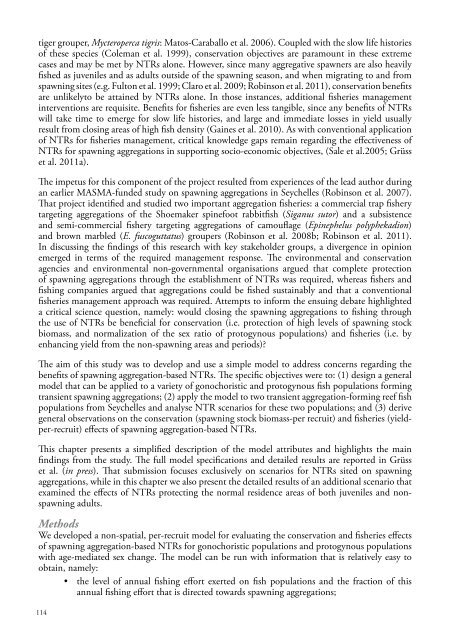WIOMSA-CORDIO spawning book Full Doc 10 oct 13.pdf
WIOMSA-CORDIO spawning book Full Doc 10 oct 13.pdf
WIOMSA-CORDIO spawning book Full Doc 10 oct 13.pdf
Create successful ePaper yourself
Turn your PDF publications into a flip-book with our unique Google optimized e-Paper software.
tiger grouper, Mycteroperca tigris: Matos-Caraballo et al. 2006). Coupled with the slow life historiesof these species (Coleman et al. 1999), conservation objectives are paramount in these extremecases and may be met by NTRs alone. However, since many aggregative spawners are also heavilyfished as juveniles and as adults outside of the <strong>spawning</strong> season, and when migrating to and from<strong>spawning</strong> sites (e.g. Fulton et al. 1999; Claro et al. 2009; Robinson et al. 2011), conservation benefitsare unlikelyto be attained by NTRs alone. In those instances, additional fisheries managementinterventions are requisite. Benefits for fisheries are even less tangible, since any benefits of NTRswill take time to emerge for slow life histories, and large and immediate losses in yield usuallyresult from closing areas of high fish density (Gaines et al. 20<strong>10</strong>). As with conventional applicationof NTRs for fisheries management, critical knowledge gaps remain regarding the effectiveness ofNTRs for <strong>spawning</strong> aggregations in supporting socio-economic objectives, (Sale et al.2005; Grüsset al. 2011a).The impetus for this component of the project resulted from experiences of the lead author duringan earlier MASMA-funded study on <strong>spawning</strong> aggregations in Seychelles (Robinson et al. 2007).That project identified and studied two important aggregation fisheries: a commercial trap fisherytargeting aggregations of the Shoemaker spinefoot rabbitfish (Siganus sutor) and a subsistenceand semi-commercial fishery targeting aggregations of camouflage (Epinephelus polyphekadion)and brown marbled (E. fuscoguttatus) groupers (Robinson et al. 2008b; Robinson et al. 2011).In discussing the findings of this research with key stakeholder groups, a divergence in opinionemerged in terms of the required management response. The environmental and conservationagencies and environmental non-governmental organisations argued that complete protectionof <strong>spawning</strong> aggregations through the establishment of NTRs was required, whereas fishers andfishing companies argued that aggregations could be fished sustainably and that a conventionalfisheries management approach was required. Attempts to inform the ensuing debate highlighteda critical science question, namely: would closing the <strong>spawning</strong> aggregations to fishing throughthe use of NTRs be beneficial for conservation (i.e. protection of high levels of <strong>spawning</strong> stockbiomass, and normalization of the sex ratio of protogynous populations) and fisheries (i.e. byenhancing yield from the non-<strong>spawning</strong> areas and periods)?The aim of this study was to develop and use a simple model to address concerns regarding thebenefits of <strong>spawning</strong> aggregation-based NTRs. The specific objectives were to: (1) design a generalmodel that can be applied to a variety of gonochoristic and protogynous fish populations formingtransient <strong>spawning</strong> aggregations; (2) apply the model to two transient aggregation-forming reef fishpopulations from Seychelles and analyse NTR scenarios for these two populations; and (3) derivegeneral observations on the conservation (<strong>spawning</strong> stock biomass-per recruit) and fisheries (yieldper-recruit)effects of <strong>spawning</strong> aggregation-based NTRs.This chapter presents a simplified description of the model attributes and highlights the mainfindings from the study. The full model specifications and detailed results are reported in Grüsset al. (in press). That submission focuses exclusively on scenarios for NTRs sited on <strong>spawning</strong>aggregations, while in this chapter we also present the detailed results of an additional scenario thatexamined the effects of NTRs protecting the normal residence areas of both juveniles and non<strong>spawning</strong>adults.MethodsWe developed a non-spatial, per-recruit model for evaluating the conservation and fisheries effectsof <strong>spawning</strong> aggregation-based NTRs for gonochoristic populations and protogynous populationswith age-mediated sex change. The model can be run with information that is relatively easy toobtain, namely:• the level of annual fishing effort exerted on fish populations and the fraction of thisannual fishing effort that is directed towards <strong>spawning</strong> aggregations;114


















